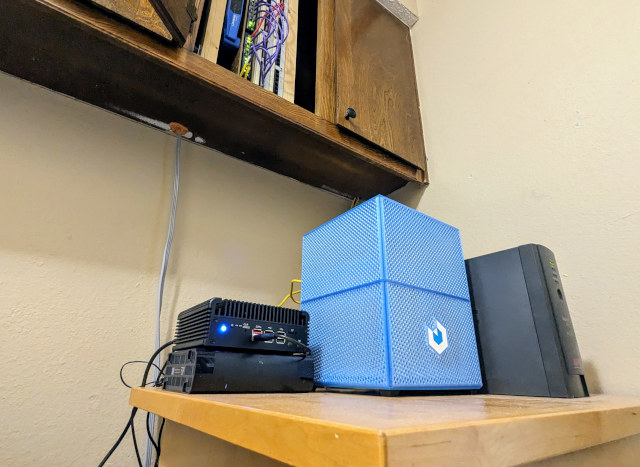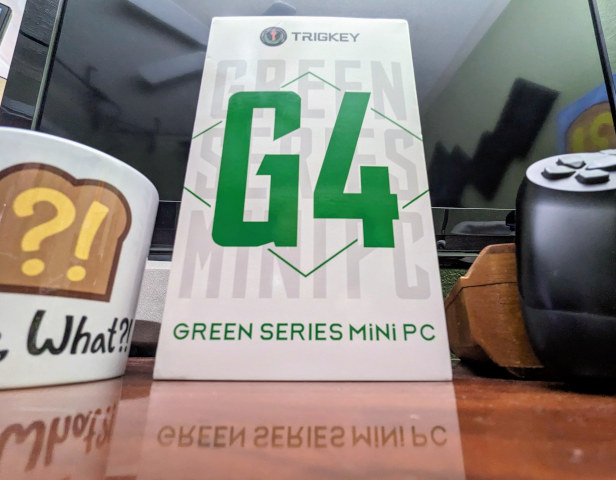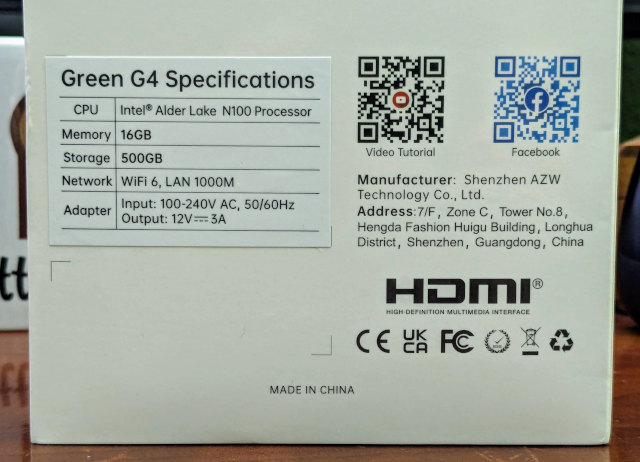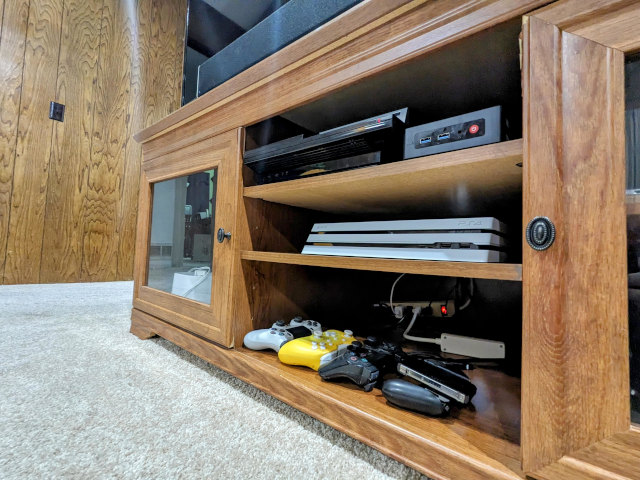Was it ACTUALLY cheaper to buy a second mini PC than to upgrade the RAM in my existing N100 server? It depends on how you look at it.
In the most literal and simplistic sense, it was not cheaper. I paid $60 more than I would have just for a RAM upgrade, but I think it will all make sense when we talk about why I made this choice.
Every N100 mini PC and mini-ITX motherboard has only one SO-DIMM slot!
This is a bummer, right? I believe all of the slightly older, slower, and less power-efficient N5095, N5105, and N6005 also had only one SO-DIMM slot, but the mini-ITX NAS motherboards built around that CPU had two DDR4 SO-DIMM slots, and those motherboards could support up to 64 GB of RAM.

On the left, my CWWK N100 Proxmox server and 14 TB USB HDD. In the center, Brian Moses’s 3D-printed Makerunit 4-bay NAS running TrueNAS Scale. On the right, my aging APC BR-800. Up top, my network cupboard.
The N100 NAS motherboards and mini PCs only have a single DDR5 SO-DIMM slot. You can pay a premium price for a 48 GB DDR5 SO-DIMM, but that is as far as they will go.
Not only that, but all the good deals on mini PCs tend to ship with RAM and an NVMe drive already installed. My router-style N100 mini PC homelab server arrived at my door with 16 GB of DDR5. If I want to upgrade the RAM, I have to pull out that 16 GB stick, put it in a drawer, and hope I figure out something useful to do with it later on.
I scratched my head, then started checking prices of N100 mini PCs on Amazon. Then I felt smart. I hope.
- Do All Mini PCs For Your Homelab Have The Same Bang For The Buck?
- I Bought The Cheapest 2.5-Gigabit USB Ethernet Adapters And They Are Awesome!
- Pat’s Mini PC Comparison Spreadsheet
- Choosing an Intel N100 Server to Upgrade My Homelab
- My First Week With Proxmox on My Celeron N100 Homelab Server
- Brian Moses’s eBay store
- Trigkey N100 Mini PC at Amazon
I definitely got more for my money by buying a second mini PC instead of a stick of RAM!
This is all going to be a little subjective because we aren’t quite comparing apples with apples. The inexpensive mini PC I chose was a Trikey N100 with 16 GB of DDR4 RAM and a 500 GB NVMe for $149. I bought this instead of a 32 GB stick of DDR5 RAM for $89.
I think this was a smart move. The 500 GB NVMe is worth at least $35. The 16 GB stick of DDR4 is worth at least $32, but that’s where the oranges come in, because 16 GB of DDR5 costs about 50% more.
I don’t know how best to assign a monetary value to the rest of the mini PC, but I reckon it is worth more than the remaining $82, and there’s definitely more value here than the $59 difference between the stick of DDR5 RAM and my new Trigkey mini PC. There’s a WiFi card in there, a fast little CPU, and a gigabit Ethernet port.
- Trigkey N100 Mini PC at Amazon
Why was I shopping for a memory upgrade?
I didn’t actually need this upgrade at all. The virtual machines and containers on my Intel N100 Proxmox server only eat up around 10 gigabytes of RAM. I have some room to grow into, and there’s even some superfluous stuff running that I could always eliminate if the need ever arises.
Right before rebooting after my upgrade from Proxmox 8.1 to 8.2, I noticed that my server was around 500 megabytes deep into swap after 62 days of uptime. I know well and good that my server would most likely be 500 megabytes into swap even if I had 128 GB of RAM in there, but that tickled my brain enough to search Amazon for prices.

When I realized how little it would cost to just buy a second Intel Celeron N100 mini PC, it was quite the challenge to resist putting one in my Amazon shopping cart.
Except that I did resist that urge. I was staring at a $145 deal on that same Trigkey N100 mini PC with 16 GB of RAM. By the time I decided that I just had to have it, the deal was gone.
There were a lot of Celeron N100 mini PC deals in the $155 to $165 range, but I somehow convinced myself that I wasn’t going to pull the trigger until I could put one in my cart at under $150.
So what am I really saying here? I wound up buying something that I don’t really need mostly for fun, but at least I got it for under $150!
- Trigkey N100 Mini PC at Amazon
- CWWK Mini PC 4-port router (Intel N100) at Amazon
The bummer about shopping for mini PCs
If you can make it work out in your favor, this bummer can be awesome.
All the aggressively priced mini PCs that are constantly being discounted ship with RAM and storage, but they never ship anywhere near maxed out. That means that if you are going to install upgraded components, you’re going to be pulling components out, and you might not have anywhere to make use of them.
You can get barebones mini PCs with no RAM or storage installed, but most of the time, those options cost more than the mini PCs that ship with some RAM and storage!
For my own homelab purposes, and probably for many of your purposes, I believe that the Celeron N100 paired with 16 GB of RAM is a nice balance. It is fortunate that they happen to ship with a reasonable amount of RAM like this.

The Trigkey N100 Mini PC has the same manufacturer address as Beelink Mini PCs, and it looks almost identical in construction!
I was a fan of the N5105 and N5095 mini PCs last year, but they almost always ship with 8 GB of RAM and only 128 GB of storage. That was fine with last year’s pricing, but today you can get a faster N100 with twice as much RAM and four times as much storage for about $25 more. It is almost silly to buy the N5095 mini PCs unless you have absolutely no use for the extra RAM or storage.
The Ryzen 5560U and 5700U Beelink mini PCs have the same problem, but in the opposite direction. They offer roughly twice as much CPU horsepower and possibly four times as much GPU grunt as the Celeron N100, but those faster Ryzen mini PCs almost always ship with 16 GB of RAM. Even worse, I believe they ship with a pair of 8 GB SO-DIMMs.
How could you make this work out in your favor? Maybe you could buy an N100 with 16 GB of DDR4 RAM, and N5095 with 8 GB of DDR4 RAM, and a single 32 GB DDR4 SO-DIMM. You upgrade the N100 to 32 GB, put that 16 GB SO-DIMM in the N5095, then throw the extra 8 GB in a drawer.
I will stick with Celeron N100 mini PCs with 16 GB of RAM in my homelab for now. Maybe they’ll get an upgrade someday when DDR5 is obsolete and people are just throwing away sticks of DDR4!
- Beelink SER5 Mini PC (Ryzen 5560U) at Amazon
The Intel Celeron N100 paired with DDR4 RAM should be slower, and that is OK!
Instead of upgrading my RAM, I added a second Celeron N100 to my homelab Proxmox cluster. Even though I didn’t precisely double the amount of CPU horsepower available in my homelab, I did come pretty close, and it didn’t cost all that much extra for that upgrade.
Much to my surprise, the DDR4 mini PC clocked in at a few percentage points ahead of the DDR5 mini PC! This isn’t a big deal. The differences are small enough that it could just be a variation in the way the wind is blowing today, but I expected this minuscule difference to be pointing in exactly the opposite direction!
Last week, my entire homelab had 16 GB of RAM paired with around 2,786 units of multi-core Geekbench 5 score. Had I swapped in a 32 GB stick of DDR5, I would still have 2,786 units of CPU horsepower.
Instead, my homelab now has 32 GB of RAM paired with 5,639 units of multi-core Geekbench score. That is the combined equivalent CPU horsepower of a $250 Ryzen 5560U mini PC
You can compare the scores of my Trigkey DDR4 vs. my CWWK DDR5 N100 mini PCs.
- Trigkey N100 Mini PC at Amazon
The differences in these benchmarks, and why Geekbench 5?!
One of the reasons that I am still using Geekbench 5 is that I own a copy. I haven’t upgraded because Geekbench 6 does not include an AES encryption test.
My personal network relies very heavily on Tailscale, and my various off-site locations are starting to have Internet connections faster than some of my machines can encrypt data. When shopping for upgrades, being able to see how much of a bump to encryption speed I might be seeing is awesome.
In most of Geekbench’s tests, my new DDR4 mini PC is faster than my old DDR5 mini PC by 2% to 5%. There are a few tests that the DDR5 box does excel at, and one of those tests is AES encryption. The more expensive N100 mini PC is ahead there by a whopping 36%.
This makes me pleased that my first homelab server has the faster RAM, because it is equipped with four 2.5 gigabit Ethernet ports. It can’t encrypt Tailscale data that fast, but the extra 36% will help use more of the potentially available pipe.
The Trigkey mini PC with DDR4 RAM only has one network port, and it is a slower gigabit Ethernet port. It can easily transfer 900 megabits per second of encrypted data via Tailscale, so that encryption deficiency isn’t going to be a real-world bottleneck for me.
Mini PCs with an N100 and DDR5 cost quite a bit more, and that is also OK!
The Beelink EQ12 Mini PC with DDR5 goes on sale frequently for $229. Never buy any of these mini PCs at full price. There will almost always be one or two sales every single week.
The Beelink N100 with DDR5 is a very different machine than the DDR4 model, so you don’t just get a potential boost in performance from the faster DDR5 RAM. You also get a pair of 2.5 gigabit Ethernet ports instead of a single gigabit Ethernet port. Depending on your use case, this is either a huge upgrade or a complete nothing burger.
My current homelab machine is even weirder. It has a Celeron N100 paired with a single stick of DDR5 RAM, but it also has four 2.5 gigabit Ethernet ports and FIVE m.2 NVMe slots! I am not yet utilizing all these extra features, but I did have to pay extra for them.
If you really do need a faster network interface, or if you grow out of your 1-gigabit Ethernet port in the future, you can add a USB 2.5-gigabit Ethernet dongle for around $7.
- Trigkey N100 Mini PC at Amazon
- CWWK Mini PC 4-port router (Intel N100) at Amazon
I didn’t account for the increase in my electric bill
My CWWK N100 mini PC burns through 0.34 kWh of electricity every day. That is a little over $15 per year where I live.
I won’t get to put a power meter on the Trigkey box to get a good reading until I put it into service running Proxmox, but I am expecting the numbers to be comparable. The CWWK box is burning some extra power with its four 2.5 gigabit Ethernet ports, and the Trigkey is running a fan.
They won’t be identical, but they ought to be pretty similar.
I paid $60 more to add this second mini PC to my homelab than I would have paid if I had just upgraded my CWWK mini PC’s RAM, and I will pay that much again in electricity over the next four years.
This might only work out to ACTUALLY being a good deal if I can manage to get some good use out of it!
UPDATE: I need to sneak this data point in here somewhere just to make sure I don’t lose it! The Trigkey N100 with a fresh Proxmox install uses 0.123 kWh over a 24-hour period. That is an average 5.125 watts.
- My First Week With Proxmox on My Celeron N100 Homelab Server
- Choosing an Intel N100 Server to Upgrade My Homelab
I want to mess around with this N100 mini PC before I put it to work!
I haven’t completely filled up my Proxmox server with virtual machines yet. I have several gigabytes of RAM to spare, and I am barely pushing this tiny CPU at all. I don’t have to rush to load Proxmox on the Trigkey server to quickly migrate a couple of virtual machines to alleviate pressure. I can take my time.
I have lots of questions about the Celeron N100. How terrible is the GPU? Can it play any games? How is the latency streaming games using Steam’s remote-play feature compared to my ancient Steam Link hardware?
I have already farted around with some of this stuff, but I don’t have much recorded data to compare it to.
What little data I have so far on gaming with a Celeron N100
Dead Cells runs locally at more than 100 FPS. This isn’t terribly surprising, but I am excited about this because the Nintendo Switch dips under 30 FPS any time there’s a lot of fire on the screen. Would an N100 on my TV be my new Dead Cells console?
I tried working my way backward in time. Borderlands 2 couldn’t even reach 20 FPS on the title screen at 720p with low settings with FSR upscaling to 1080p. Borderlands GOTY Enhanced Edition could break 30 FPS with the same settings. I don’t even like playing first-person shooters at 60 FPS, so I can’t imagine doing it at 30 FPS!

I squeezed the Trigkey N100 with Steam onto our TV stand in the living room right next to the PlayStation 3!
Gunfire Reborn is a well-optimized game with relatively simple graphics. I could get it running at over 50 FPS, but most people would consider this to be playable!
I spent ten minutes streaming games from my computer to the Celeron N100 mini PC over gigabit Ethernet. I was seeing around 8 milliseconds of streaming latency over gigabit Ethernet and 13 milliseconds with the mini PC connected to 5.8 GHz WiFi and the gaming PC connected to gigabit Ethernet. Is that good? That is roughly half of a frame at 60 FPS. My cheap Alldocube Android tablet was seeing around 24 milliseconds of latency over WiFi.
I can tell you that Dead Cells was unplayable with 24 milliseconds of latency, but Red Dead Redemption 2 only felt a little off with 70 milliseconds of latency over T-Mobile’s 5G network.
Emulation might be where it is at
I am a huge fan of emulating old gaming systems. I built an arcade cabinet with all my favorite childhood games installed. I own an Anbernic RG35XX, and I use it to play all sorts of NES and SNES games. It doesn’t take a lot of horsepower to emulate these older systems.
I have not yet tested this myself, but it looks as though the Celeron N100 has enough horsepower to emulate just about anything up to and including the Nintendo Wii U. That is exciting, because there are a few good romhacks of The New Super Mario Bros. Wii with completely new and awesome levels to play. I haven’t gotten to play those since I gave away my modded Nintendo Wii, and I bet there are fun romhacks for the Wii U that I haven’t even heard of.
My choice won’t make sense for everyone!
My chonkiest VM has 3 GB of RAM allocated to it, and the majority of the services I might want to run here at home would probably fit in 1 GB or less. That makes 16 GB feel spacious, and it isn’t a big deal for me to split my virtual machines up between two or more hosts with only 16 GB of memory each.

Someone with different needs might feel claustrophobic in this sort of space. If you have lots of virtual machines that each require more than 8 GB of RAM, then you’re going to have a hard time divvying those up between Proxmox servers with only 16 GB of RAM.
Just because this was a good deal for me does not mean it will be a good idea for you, but even if it isn’t, maybe the line of thinking that got me here will lead you down a comparable path.
Conclusion
This is for sure not the conclusion. This is only the beginning, right?! I don’t know what experiments outside of emulation and video games I will come up with for this Intel N100 mini PC from Trigkey, but I expect I will come up with something!
I haven’t decided where its permanent home will be. Should it live right next to the CWWK N100 mini PC underneath my network cupboard? Should it live in my office so it can marginally streamline my Octoprint setup for my Sovol SV06 3D printer? It would be nice to attach another 14 TB USB hard disk to it so I could have a second on-site backup of my data on the exact opposite side of the house.
What do you think? Did I make the right move by buying a second mini PC instead of a RAM upgrade? Are you now thinking about doing the same thing to upgrade your homelab? Is it disingenuous to say this was cheaper than buying a stick of RAM? I still feel like I saved money, but am I wrong about that? Let me know in the comments, or stop by the *Butter, What?! Discord server to tell me why I am wrong!
- Choosing an Intel N100 Server to Upgrade My Homelab
- Pat’s Mini PC Comparison Spreadsheet
- I Bought The Cheapest 2.5-Gigabit USB Ethernet Adapters And They Are Awesome!
- Do All Mini PCs For Your Homelab Have The Same Bang For The Buck?
- Using an Intel N100 Mini PC as a Game Console
- My First Week With Proxmox on My Celeron N100 Homelab Server
- Brian Moses’s eBay store
- Trigkey N100 Mini PC at Amazon
- CWWK Mini PC 4-port router (Intel N100) at Amazon